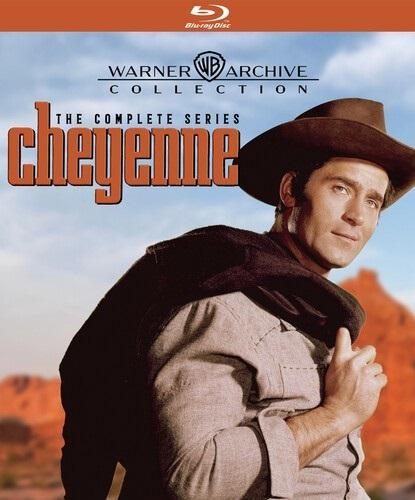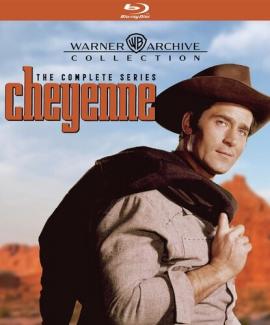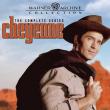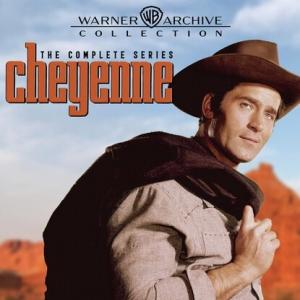‘Cheyenne’ led the golden age of TV Westerns
Cheyenne: The Complete Series (1955-1962, Warner Archive Collection, 30 Blu-rays, NR, 5,560 min.). Beginning with “Cheyenne” in the mid-1950s, Warner Bros. produced several entertaining Western series, including “Maverick” (1957-1962), “Sugarfoot” (1957-1961), “Bronco” (1958-1962), “Lawman” (1958-1962) and “Colt .45” (1957-1960). All ran on ABC originally and most were staple viewing in my family’s home. I was only 7 when “Cheyenne” first aired and it and “Maverick” were my favorites, along with “Wagon Train” (1957-1965), which ran first on NBC and then on ABC.
“Cheyenne” was centered around 6-foot 6-inch Clint Walker as Cheyenne Bodie, a wanderer in the post-Civil War West. For the most part, Cheyenne, whose name came from his being raised by the Cheyenne for eight years of his childhood after Native Americans killed his parents, works alone, using his own ethical code and willingness to help others. For three of the first four episodes, he is accompanied by Smitty Smith (L.Q. Jones of “The Wild Bunch,” “Mask of Zorro”), but then Smitty disappears. Initially, the pair were hired by the Army to do mapping.
No other characters were continuing, although several actors were frequently used in guest or bit roles. Clyde Howdy appeared as a variety of characters, many times as “Townsperson,” in 49 episodes, while Chuck Hicks plays assorted characters in 15 episodes and Lan Chandler appears in 10 episodes as different characters.
“Cheyenne,” whose 107 episodes, all meticulously remastered from 4K scans of the original camera negatives, are all included in this box set, was the first “hour-long” (actually 42 minutes minus the ads) Western on television. It also was the first hour-long dramatic series of any kind, with continuing characters, to last more than one season. The seven seasons were noted for their gun-blazing action and panoramic prairie vistas.
Many who went on to fame in TV productions appeared in this series first. Among them were James Garner (the future star of “Maverick,” “The Rockford Files”), Edd Byrnes (“77 Sunset Strip”), Alan Hale Jr. (“Gilligan’s Island”), Dan Blocker, Lorne Greene and Michael Landon (all “Bonanza”), Lee Van Cleef (Sergio Leone’s “Dollars Trilogy” films and many a TV Western bad guy), Angie Dickinson (“Police Woman"), Connie Stevens (“Hawaiian Eye”) and Ellen Burstyn (“House of Cards” and several early Western TV show appearances).
Richard L. Bare, who also worked on “77 Sunset Strip” directed many of the early episodes. He directed 21 “Cheyenne” episodes in all, nearly one-fifth of the total run. The next highest was Leslie H. Martinson (“Batman: The Movie,” 9 episodes of TV’s “Mission: Impossible”), who helmed 13 episodes.
A look at the first four episodes gives the flavor of the show. In the pilot, “Mountain Fortress,” Cheyenne and Smitty come across Bob Monson (Bob Wilke) and his small gang, just before War Cloud leads a Cheyenne raid on a stagecoach. Monson’s men, helped by Cheyenne and Smitty, withstand the tribe’s initial attack on their higher mountain position. With the attackers gone, Monson’s men rob the stagecoach, but also find one survivor. She is Joan Carter (Ann Robinson), who was coming to visit her fiancé, Army Lt. Brad Forsythe (James Garner) at the nearby fort. The Cheyenne attack again with reinforcements and ladders. At one point, the youngest of Monson’s men talks about meeting Gen. Robert E. Lee, a nice humanizing moment which, of course, means the young man will not survive.
Episode two, “Julesburg,” is about a bad town. Cheyenne and Smitty comes across a wagon train that is headed for Wyoming. The travelers have been attacked by rustlers, who work for McCanles (Ray Teal). McCanles tries to sell the stolen 223 coattle to the Barnes (David Alpert and Adelle August), who are brokers for a company back East. Cheyenne and Smitty go undercover, along with young Tommy (Billy Chapin), whose brother was killed by the rustlers, to get the cattle back. This time, our heroes are trapped on the second floor of a hotel.
Smitty is absent in episode three, “The Argonauts,” which has Cheyenne fall in with gold prospectors Clancy (Rod Taylor of “The Time Machine,” “The Birds,” “One Hundred and One Dalmatians”) and Dunc (Ed Andrews), as they had lost the map to their mine but Cheyenne knew the location by their description. Gold is found, but Dunc is too mistrustful of the others, leading to problems. This is an especially well-written episode.
In episode four, “Border Showdown,” Smitty returns for the final time as he and Cheyenne travel to the Mexican town of Paso Alto to bring back a bank robber (Myron Healey as Carl Thompson), who killed a man during his escape. Thompson has taken over the town, after killing 14 young men who tried to stop his gang, and locked up all the townspeople’s weapons. Cheyenne wants to bring Thompson back to the U.S. to stand trial, so he cannot be killed. That does not go for the rest of Thompson’s rather large gang, however.
The only extra in the set is a 2006 interview with Walker, in which he talks about his early life and how he got the role of “Cheyenne” (13:44). Grade: series 3.75 stars; extra 2.25 stars
Rating guide: 5 stars = classic; 4 stars = excellent; 3 stars = good; 2 stars = fair; dog = skip it
Springfield Rifle (1952, Warner Archive Collection, Blu-ray, NR, 93 min.). Gary Cooper (“High Noon,” “Sergeant York,” “Mr. Deeds Goes to Town”) stars as U.S. Army Major Alex “Lex” Kearney in this Civil War-era film. Kearney, in order to learn who is behind the rustling of Army horses, gets kicked out of the military and then poses as a Confederate sympathizer. Some 4,000 horses, needed for use in the open country of the West, have been stolen, and it appears someone may be tipping off the rustlers as to the routes the horses and soldiers will use.
Despite being forbidden from returning to Army property, with a possible death penalty pending, Kearney manages to get arrested with two of the horse rustlers who were captured. He then becomes part of their escape and learns the location of 984 horses stolen in the last five raids.
Cooper has an active role, including two fistfights. There also is one large shootout, as Andre de Toth (“House of Wax,” “Hidden Fear”) directs and the screenplay is from Charles Marquis Warren, the creator of “Gunsmoke,” and Frank Davis. The music score is by the great Max Steiner (24 Oscar nominations, scores for “Casablanca,” “Now, Voyager,” “King Kong,” “The Searchers,” “A Summer Place”).
Among the cast are Martin Milner (TV’s “Adam-12”) as Pvt. Olie Larsen, Alan Hale Jr. (TV’s “Gilligan’s Island”) as Mizell, Lon Chaney Jr. (“The Wolf Man,” “High Noon,” “Of Mice and Men”) as Pete Elm, William Fawcett (“Batman and Robin,” “The Adventures of Sir Galahad”) as Cpl. Ramsey, David Brian (“Flamingo Road”) as Austin McCool and Paul Kelly (“The Secret Code”) as Lt. Col. John Hudson.
Extras include two Merrie Melodies cartoons, “Feed the Kitty” (7:23) and “Rabbit’s Kin” (6:53) with Bugs Bunny; and the Joe McDoakes short comedy “So You Want to Enjoy Life” (10:59). Grade: film 3 stars; extras 2 stars
Side Street (1949, Warner Archive Collection, Blu-ray, NR, 82 min.). Farley Granger (“Stranger on a Train,” “Rope”) plays father-to-be Joe Norson, barely making it by as a part-time postman but wanting to buy his wife (Cathy O’Donnell as Ellen) a fur coat. So, when he sees $200 fall to the floor of a lawyer’s office and get stuffed in a cabinet, he thinks about stealing the money when the next day he finds the office empty. Unfortunately for Joe, the file he takes actually holds $30,000, blackmail money from married stockbroker Emil Lorrison (Paul Harvey of “Spellbound,” “High Sierra”), who was having an affair with Lucille Corner (Adele Jergens of “Armored Car Robbery”).
Joe takes less than $300 of the loot, then wraps up the rest and gives it to his bartender friend Nick Drumman (Edwin Max of “The Incredible Melting Man”) to hold for him, as Joe eventually plans on returning the cash. However, Joe finds the cash is missing when he gives the package to attorney Victor Backett (Edmon Ryan of “Topaz,” “Tora! Tora! Tora!). Meanwhile, Nick has retired and sold the bar, having obviously taken the money.
Even stranger to Joe is that Backett claims he was never robbed. That is because a number of bodies is starting to build up, including Corner. Involved in the blackmail, and the main killer, is James Craig (“The Human Comedy,” “The Devil and Daniel Webster”) as George Garsell. Garsell’s nightclub-singing ex-girlfriend, whom Joe tracks down, is Harriet Sinton (Jean Hagen of “Singin’ in the Rain,” “Adam’s Rib,” TV’s The Danny Thomas Show”).
The film, directed by Anthony Mann (“El Cid,” “The Glenn Miller Story”), was shot in New York City by cinematographer Joseph Ruttenberg (4-time Oscar winner for “Gigi,” “Somebody Up There Likes Me,” “Mrs. Miniver,” “The Great Waltz”). The film is known for its final police chase of a taxicab, often shot from high up – like 30th floors – and echoing the helicopter shots of lower Manhattan at the film’s start.
Extras include audio commentary by critic Richard Schickel; a discussion of the film by Schickel, Oliver Stone and Patricia King Hanson, executive editor of the “AFI Catalogue,” among others (5:49; 2007); and two classic cartoons, “Polka Dot Puss” from Hanna-Barbera (7:45) and “Goggle-Fishing Bear” (7:21). Additionally, there is an excellent short “Crime Does Not Pay” film, “The Luckiest Guy in the World” (21:09), starring Barry Nelson (“Bataan,” “Winged Victory,” and he played James Bond in TV’s “Casino Royale” in 1954) as a man who almost gets away with two murders. Grade: film 3.25 stars; extras 3 stars
The Good German (2006, Warner Bros., 4K Ultra HD + Blu-ray, R, 108 min.). Director Steven Soderbergh’s stylish film is set in post-World War II Berlin, just before and during the meeting of Winston Churchill, Harry S. Truman and Vladimir Lenin in Potsdam to carve up Nazi-controlled Germany and its occupied territories. The film is in black-and-white to match the footage of real war destruction and scenes from the actual Potsdam conference. The matching up is done seamlessly and is a huge asset.
The film is narrated by Tully (Tobey Maguire of the “Spider-Man” franchise), who works in the U.S. Army motor pool, illegally selling surplus and other stuff to the Russians. Tully says the war, other than the millions who were killed, was the best thing to happen to him. However, Tully only lasts 27 minutes into the film.
Tully is assigned to be the driver of journalist Jake Geismer (George Clooney of “Michael Clayton,” “Up in the Air,” “Batman & Robin,” the “Ocean’s” heist films), a reporter for the New Republic, who is to report on the Potsdam conference. Tully just happens to be dating Lena Brandt (Cate Blanchett of “The Lord of the Rings” and “The Hobbit” films), whom Geismer used to date when he employed her as a stringer pre-war. A further wrinkle is Lena is married to Emil Brandt, the assistant of one of the developers of the Nazi rockets that bombed London, someone the U.S. government wants for its rocket program.
When Tulley’s body appears in the river near the Potsdam conference, Geismer seems to be the only one who wants to solve his murder.
Beau Bridges (“The Fabulous Baker Boys”) plays U.S. Army Col. Muller and Ravil Isyanov plays Russian General Sikorsky. The plot is the film’s weakest part, but it looks very good. Grade: film 3 stars
Seneca (Germany, 2023, Freestyle, DVD, NR, 111 min.). John Malkovich (“Dangerous Liaisons,” “Being John Malkovich”) is solid as the title character in the film by Robert Schwentke, who also co-wrote with Matthew David Wilder, about the last day of Seneca, after Roman president Nero (Tom Xander) orders soldier Felix (Andrew Koji of “Bullet Train”) to kill his advisor.
Early on, the film shows Seneca trying to teach Nero how to speak effectively and trying unsuccessfully to urge Nero towards mercy. Instead, Nero kills his wife Octavia and sends her head as a wedding present to Poppaea, his new bride. At one point, the film turns quirky, having Nero play an electric guitar. There also is usage of some very current words, like “memes,” that is anachronic.
The middle of the film is given to a play Seneca puts on for a small group of his rich, idle friends. While supposedly based on Greek history, the play clearly is about Nero and, proving Seneca’s own brutality, it includes the real beheading of two black slaves.
Then, Felix arrives, gives Seneca until morning to kill himself, and Seneca apparently spends hours speaking his final words – Lucilius (Louis Hofmann of TV’s “Dark”) is his young scribe – before botched attempts to kill himself and his much younger wife Paulina (Lilith Stangenberg).
While there is some dry wit, especially when Paulino lists Seneca’s physical deficiencies, overall, the film leaves one queasy, if not a bit bored. Grade: film 2.25 stars
V13 (Deskpop Entertainment, DVD, NR, 102 min.). This talky film – obviously based on a play, as indeed it was – gives us a young, angst-ridden Adolf Hitler as a struggling artist at an art museum on his birthday in Vienna 1913. The name Hitler is not used until the very end of the film, but it is so obvious from the get-go that Adolf is Hitler. Through the film, Adolf becomes influenced by German Nationalism politics and antisemitism. Yet he befriends young pianist Hugo Hausler, who is rich opposed to Adolf’s poverty and an antisemitic, even though Hausler’s grandfather, unknown to him, is Jewish.
We also see how Sigmund Freud and Carl Jung, once aligned in their ideologies, diverge from each other, as Jung develops his own school based on analytical psychology, while Freud uses psychoanalysis, heavy on dreams. Most of Freud’s sessions are rendered in black-and-white, with Hausler the usual patient. Weirdly, during latter sessions, the camera pulls back to reveal Freud and Hausler are on a stage in an empty theater. Freud identifies Hausler's dream symbols as an incestuous desire for his mother.
This cerebral film is not for the casual viewer. There is liberty taken by director Richard Ledes to ignore historical accuracy in terms of accents, costume, locations and even race for Jung. Grade: film 2.75 stars
New 4K Ultra HD upgrades
Dirty Harry (1971, Warner Bros., 4K Ultra HD, R, 102 min.). Clint Eastwood began his 54-year association with Warner Bros. with the release of this action film, which Don Siegel directed. Eastwood plays a no-holds-barred San Francisco cop, Harry Callahan, in this thriller that began an action franchise. When Detective Callahan is assigned to pay extortion money to a serial murderer, the payoff goes wrong. Now with the life of a 14-year-old girl at stake, Callahan refuses to allow anything -- including the law -- to keep him from stopping Scorpio, the killer. The film was selected in 2008 by Empire as one of The 500 Greatest Movies of All Time and it was ranked No. 41 on the American Film Institute’s 100 Years ... 100 Thrills, a list of America's most heart-pounding movies, and Harry Callahan was selected as the 17th greatest movie hero on 100 Years ... 100 Heroes & Villains.
It comes with more than four hours of special features, including audio commentary by Richard Schickel, five featurettes and two documentaries. The new featurettes are “Generations and Dirty Harry” (6:15) and “Lensing Justice: The Cinematography of Dirty Harry” (7:54). Grade: film 3.25 stars; extras 4 stars
The Outlaw Josey Wales (1976, Warner Bros., 4K Ultra HD, PG, 135 min.). Clint Eastwood stars in and directs this fast-paced Western about the fight for vengeance by a Missouri farmer whose family is murdered in the last days of the United States' Civil War. Again, his character is out to get the bad guys with no regard to the law. When Northern troops cold-bloodedly murder some of his comrades, he mows down the Yankees with a Gatling gun and becomes a fugitive. As Wales successfully evades groups of bounty hunters, wiping out six to 10 each time before they can get off a shot, he keeps continues to pick up refugees along the way out West, including a young Indian girl and then the survivors of a Kansas family that was nearly wiped out.
The extras again include audio commentary by Richard Schickel. There also are five featurettes and one documentary. The new featurettes are “An Outlaw and an Antihero” (7:22) and “The Cinematography of an Outlaw: Crafting Josie Wales” (7:55). Grade: film 3.75 stars; extras 4 stars
Pale Rider (1985, Warner Bros., 4K Ultra HD, R, 115 min.). Clint Eastwood returned to the Western genre with the highest grossing Western of the decade. Eastwood plays a nameless stranger who rides into a small California gold rush town, where he prefers to be known as the "Preacher," after he finds himself in the middle of a feud between a mining syndicate and a group of independent prospectors. This was the 10th film in which Eastwood directed himself.
The extras include two new featurettes, “The Diary of Sydney Penny: Lessons from the Set” (7:26) and “Painting the Preacher: Bruce Surtees and Pale Rider” (8:36); and two documentaries. Grade: film and extras 3.5 stars
The Informant! (2009, Warner Bros., 4K Ultra HD, R, 108 min.). Matt Damon stars in this true story of the highest-ranking corporate whistleblower in U.S. history. Damon plays Mark Whitacre, out to expose the agribusiness corporate baddies who are illegally fixing the price of food additives. The film, often a black comedy, is directed by Steven Soderbergh (“The Good German”), who directed Damon in the “Ocean’s” trilogy. Extras include audio commentary by Soderbergh and screenwriter Scott Z. Burns, plus four additional scenes (6:26). Grade: film 3.75 stars; extras 2.75 stars
About this blog:

My music review column, Playback, first ran in February 1972 in The Herald newspapers of Paddock Publications in Arlington Heights, IL. It moved to The Camden Herald in 1977 and to The Courier Gazette in 1978, where it was joined by my home video reviews in 1993. The columns ran on VillageSoup for awhile, but now have this new home. I worked at the Courier Gazette for 29 years, half that time as Sports Editor. Recently, I was a selectman in Owls Head for nine years.




























